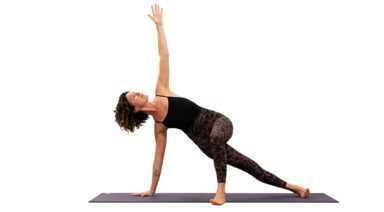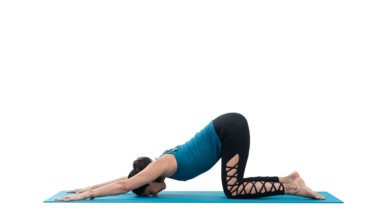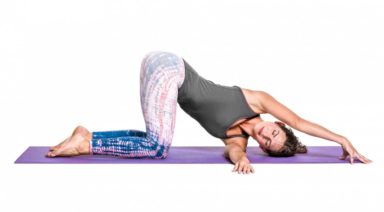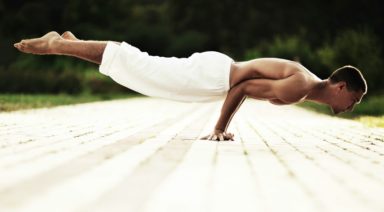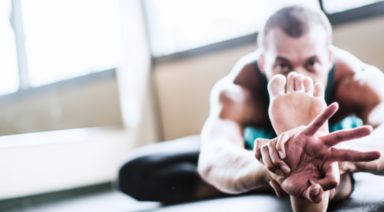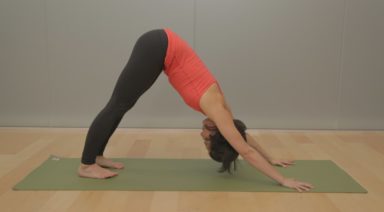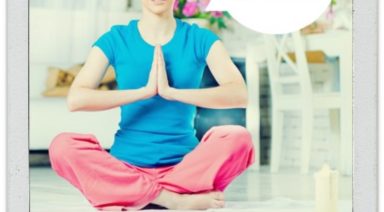Open Your Pelvis: Deep Straddle, Front Splits in Yoga

I grew up in the 1980s in the U.S.A. and one of my first fitness memories was of the “Thigh Master”. This invention was sold as toning the thighs and giving a sleek looking leg to the user. The exercise had the result of tightening the inner thigh muscles. Without much technical instruction the do-it-yourself home workout junkie would just squeeze the inner thighs muscles, including the Adductors, Gracilis and Pectineus. When I started practicing yoga the one area of serious tightness that I found on my body was my inner thighs. When your inner thighs are tight and over worked it can restrict healthy inward and outward rotation of the hip joint. In the yoga practice we rely on a healthy range of motion in the hip joint to practice most of the postures. Yoga practitioners who find their inner thighs a little tight need to take the time to understand how to soften and release this tender area in order to practice safely.
The thighs form the gateway to the pelvis and opening the muscles along the thighs takes patience, humility and good alignment. Between the hamstrings, the quadriceps and the inner thigh muscles, the upper legs create a solid protection for the pelvis. In yoga you practice how to let go of all unnecessary protection so that the body can relax. In essence flexibility is about laying down the armor of the body so its natural state of peace and harmony can be revealed. That’s easier said than done.
When I first started attempting to deepen my front splits I realized that my inner thighs were blocking the pathway. This is a sensitive area to work with in the body that cannot be rushed. In the Ashtanga Yoga Primary Series many students who are eager to open their inner thighs in postures like Upavistha and Supta Konasana end up creating injury out of their enthusiasm. As a teacher I strongly encourage students not to push themselves too hard while in these postures. Eager students will sometimes grab hold of their feet and attempt to force their torso down to the floor between their thighs. But without waiting for the body to relax and release its protection, the tightness around the thighs cannot release and they only end up making their body tighter. In the worst-case scenario that I have witnessed, a student injures their hamstring or inner thigh attachment around the sitting bones while attempting to go deeper. This can all be avoided if you work patiently, surrender the go and apply healthy alignment principles while working the yoga postures.
In the yoga practice, we cannot control when the body will release and open. All we can do is show up each day and practice while letting go of the need to get any particular result. The openings and transformations that happen through yoga practice occur because we surrender ourselves to the divine and in that grace we experience our natural freedom. There is no way to rush that process. But I know first hand how frustrating it can be to turn up every day on your mat and not feel like there is any improvement. When I work with front splits I get impatient and want to hurry along the tedious journey of softening an area of tightness. If you are also working on front splits this video will help you find a safe path to opening the inner thighs.
Standing Tall: Why Posture Matters

Remember how your mom used to always lecture you to stand up straight? Well, she might have made some mistakes over the years (that outfit in your 5th grade school picture), but on this one, she’s right. Posture matters more than you may think.
First, let’s talk about your body, starting at the top. Each inch your head is forward of your shoulders doubles the amount of weight it puts on the rest of your body. Although the average head only weighs between 8-10 pounds, your upper back (and then lower back and hips) will become misaligned if your head “lives” in a forward position – all in an attempt to balance your now-too-heavy head.
And, unless you sit in an ergonomically perfect workstation, chances are you round forward over your keyboard or laptop like something straight out of the latest episode of the “Walking Dead.” Most of us, sadly, are in the process of developing this posture. Blame the Internet (we’re talking to you, Mark Zuckerberg) or your boss (for making you work too much).
What happens to our bodies? Back pain, neck pain, hip pain and knee pain. And, let’s not forget your breathing. Collapsing forward compresses your lungs, reducing their capacity by 30 percent or more. Your organs can’t function properly, and neither can your muscles, joints, or connective tissue.
Posture also matters for your mental health. Good posture allows you to breathe more fully, calming your nervous system, which can help with everything from good sleep to good moods. Plus, standing up tall makes you feel more confident. Slouching pulls your energy downward, even making walking and balance more difficult.
What to do? First, analyze your own posture. Do your shoulders slouch? Is your head forward? Do you have back or neck pain? When you walk do you have a tendency to lean forward and feel like you’re lifting your knees towards you?
Since it is vital to have extension in the upper torso in standing posture, the starting place is simply awareness of how you’re standing or sitting. Imagine lifting out of your pelvis, shoulders back, head looking slightly above the horizon.
Don’t spend too much time sitting at your desk, especially in bad posture. Take a walk. Inhale your arms overhead and slightly back. Regularly engage your lower trapezius to draw your shoulders away from your ears, and your rhomboids to draw your shoulders together.
And balance the forward posture with a lot of back bends. Stretch your pecs and anterior shoulder muscles with anahatasana pose (think child’s pose with your hips over your heels, reaching your tailbone and chest away from each other). Camel pose has been called the “antidote to sitting” because it stretches the entire front of your body.
If you have access to a Pilates reformer, you’re in luck. Do seated arm circles to take your shoulders through a weighted stretch, and turn around for chest expansion to, well, expand your chest and your lung capacity. Or just lie down on a mat, extending arms and legs long on the floor, and lift up, fluttering arms and legs in opposition while breathing deeply.
Most importantly, throughout your day, remember to stand up straight. Don’t slouch. Just listen to mom on this one. You can still argue about your clothes, your politics, and what’s for dinner. On posture, she’s right.













